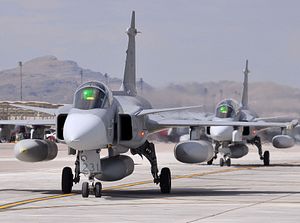Saab is trying to find customers in Asia. A recent report indicated that the Swedish defense firm is trying to find partners in Asia for the Sea Gripen, a carrier-launched version of its much-lauded, relatively inexpensive Generation 4.5 fighter.
The problem is that the market for fighter aircraft is tight, because there are several good competitors and not enough aircraft carriers to go around. Thus have culminated a pair of long-standing trends in naval and aviation acquisition: good aircraft are chasing decks that simply don’t exist. To see how we got here, it’s useful to trace a bit of the intertwined histories of carriers and airwings.
The first generation of small carriers were mostly Colossus and Majestic class light carriers, sold by the United Kingdom in the wake of World War II. These ships served a variety of navies around the world, including several in Asia. Their air wings varied a lot over time, from piston-engined fighters near the end of World War II to helicopters and small jets in the 1970s. Embarked aircraft included the A-4 Skyhawk, F9F Panther, Super Etendard, and Hawker Sea Hawk, among others. These ships (and most of the aircraft) began to leave service in the 1970s and 1980s.
The next generation of purpose-built ships includes such vessels as the Thai Chakri Naruebet, as well as a few small European carriers. These ships often carried variants of the AV-8 Harrier, along with a collection of helicopters. The Harrier is a notoriously difficult aircraft, however, especially for navies that considered aviation a luxury, rather than a necessity. For this kind of carrier the F-35B would fit the bill nicely, except for the expense. Most of these ships are still in service, although the Harrier is on its last legs.
The current generation has witnessed a high-low split. Cost-conscious navies have determined that larger, purpose-built carriers don’t offer sufficient bang-for-the-buck, especially with regard to humanitarian assistance/disaster relief (HADR). Helicopters, drones, and (for the fortunate) the V-22 Osprey would seem likely to dominate this generation, although there is still some prospect that the F-35B might fly off some of these carriers.
China, India, Russia, France, the U.K., and the United States, on the other hand, have decided to concentrate on large carriers designed to accommodate conventional fixed wing aircraft. This would seem to present a viable market, but four of the six have decided on domestically produced fighters, and the British have settled on the F-35B.
This means that, for all intents and purposes, India and Brazil are the beginning and end of the market that is being pursued by Mikoyan (MiG-29K), Sukhoi (Su-33), Saab (Sea Gripen), Boeing (F/A-18), Lockheed Martin (F-35B, F-35C), Shenyang (J-15, J-31), HAL (Tejas), and Dassault (Rafale), and even Brazil needs to sort through its long-term carrier plans before it buys a new fighter.
Unless there’s some kind of significant change in shipbuilding policies, most of these companies are going to be shut out of anything but their domestic markets. At the same time, there remains a potential niche that could be exploited by a firm that could design a VSTOL aircraft capable of operating from small carriers and amphibs, and that could sell for cheaper than the F-35B. Unfortunately, that’s a tall order.
































